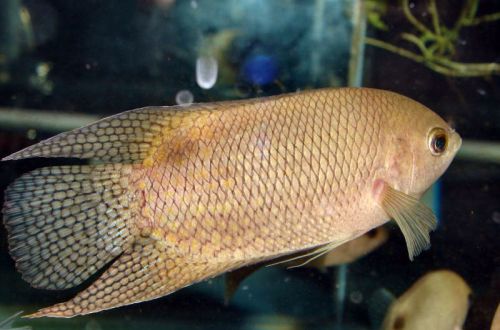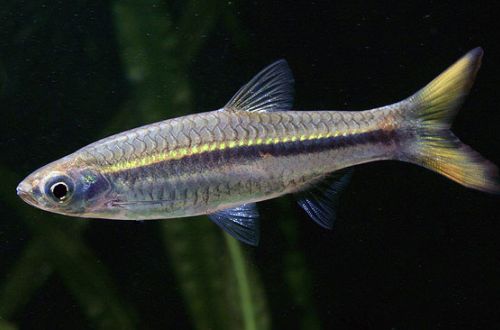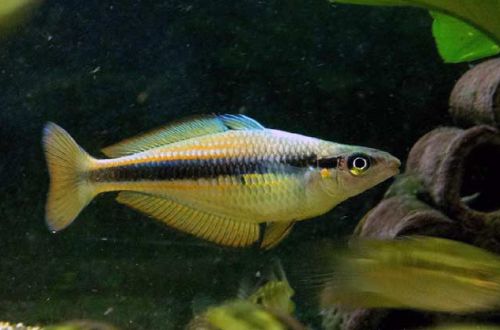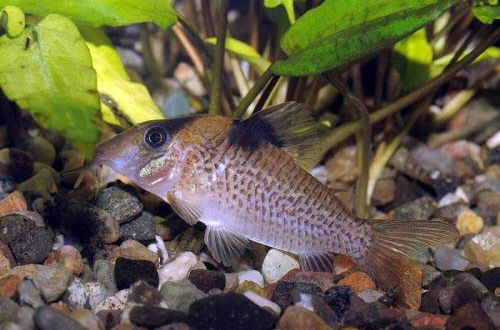
Belotonia Hasselda
Hasseld’s Belothonia or Honeycomb-tailed macropod, scientific name Belontia hasselti, belongs to the Osphronemidae family. Large massive fish, has an unfriendly character and is very aggressive towards small species that can easily become its snack. The selection of aquarium neighbors is not the only problem that will have to be solved, the diet can also cause difficulty, so Belontia is not recommended for a novice aquarist.

Contents
Habitat
It comes from the Greater Sunda Islands (Sumatra, Java, Kalimantan), Peninsular Malaysia and southern Thailand. It lives in small sluggish rivers and swampy lakes in the rainforest canopy. Dense crowns of trees let in very little light, the level of illumination is very low. The water has a rich brown hue due to the abundance of humic acids and other chemicals that occur during the decomposition of organic matter.
At present, the habitat has been severely degraded as a result of human activities, so fish are forced to develop a new habitat – rice fields, canals, ditches near settlements, etc.
Brief information:
- The volume of the aquarium – from 150 liters.
- Temperature – 21-26°C
- Value pH — 4.5–7.5
- Water hardness – soft (1-10 dGH)
- Substrate type – any
- Lighting – subdued
- Brackish water – no
- Water movement – little or no
- The size of the fish is up to 20 cm.
- Food – meat
- Temperament – inhospitable
- Keeping alone or in pairs male / female
Description
Adults reach up to 20 cm in length. Coloring uniform light milky shade. A characteristic feature is a mesh pattern in the form of honeycombs on the tail and fins, which is clearly manifested during the spawning period, the rest of the time the pattern is not so noticeable. There is a large dark spot at the base of the dorsal fin closer to the tail. Sexual dimorphism is weakly expressed, females differ mainly in smaller size.
Food
They are carnivorous species, in nature they feed on invertebrates, molluscs and small fish. In a home aquarium, you can feed live or frozen food, such as earthworms, pieces of mussels, snails without shells. In most cases, breeders adapt the diet to dry kibbles, which significantly reduces maintenance costs, so be sure to check the diet of the Hasseld Whitetonia before buying.
Maintenance and care, arrangement of the aquarium
The recommended volume of the tank for one pair of fish starts from 150 liters. The design uses a soft sandy substrate, groups of rooting and floating shade-loving plants and shelters in the form of snags or other decorative objects (wrecks, castles, etc.), or ceramic pots turned over on their side.
An additional design element is the dried fallen leaves of trees, which are lined with the bottom so that they begin to sink, the leaves are pre-soaked in a container of water. The leaves also contribute to the establishment of the natural water composition characteristic of natural reservoirs. In the process of decomposition, the water is saturated with humic acids and it turns into a light brown color.
Optimal housing conditions are achieved with slightly acidic pH values, low carbonate hardness, low light levels and no internal flow. The equipment is selected in accordance with these conditions.
Maintenance of the aquarium comes down to regular cleaning of the soil from organic waste, weekly replacement of part of the water (10-15% of the volume) with fresh water and replacing the leaves, if present, once every two weeks.
Behavior and Compatibility
Males are very aggressive towards each other, especially during the spawning period, they show similar behavior towards smaller fish, which, on occasion, can even be eaten. In a large aquarium from 200 liters, it is allowed to combine with large representatives of cyprinids and haracins, but with a smaller volume, a single or paired (male / female) content is desirable.
Breeding / breeding
The signal for the beginning of the mating season is a change in the color of the male – the honeycomb pattern becomes distinct and a noticeable increase in the female’s abdomen, swollen from caviar. When the couple is ready, the fish begin a kind of embrace dance and at the same time release eggs and seeds – fertilization occurs. Since the male, unlike most labyrinths, does not build a nest, he collects eggs in his mouth, where they stay for the entire incubation period, which is about three days. After a few days, the fry that appear will be able to swim around the aquarium on their own.
In order to preserve and protect the offspring, it is recommended that the juveniles be carefully caught and relocated to a separate tank with identical water conditions.
Fish diseases
The main cause of most diseases is unsuitable living conditions and poor-quality food. If the first symptoms are detected, you should check the water parameters and the presence of high concentrations of hazardous substances (ammonia, nitrites, nitrates, etc.), if necessary, bring the indicators back to normal and only then proceed with treatment. Read more about symptoms and treatments in the Aquarium Fish Diseases section.





